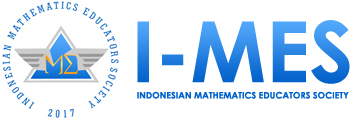Efektifitas Project Based Learning-STEM dan Pemecahan Masalah Matematis Siswa pada Materi Trigonometri
DOI:
https://doi.org/10.35706/sjme.v6i2.6588Abstract
The purpose of this study was to analyze the effectiveness of Project Based Learning-STEM (PjBL-STEM) associated with the variable Mathematical Problem Solving Ability (KPM) on trigonometric material. The research method uses a quasi-experimental design with Nonequivalent Control Group Design. The problem-solving abilities studied include: understanding the problem, planning for completion, completing according to plan, re-examining the calculation results. The results and conclusions of this study are (a) the effectiveness of the learning process of teachers and students can be categorized as good based on the average results on the observation sheet that has been assessed by the observer; (b) based on independent t-test there are differences in the improvement of students' mathematical problem solving abilities who receive STEM-based Project Based Learning (PjBL-STEM) learning with conventional learning, where STEM-based Project Based Learning (PjBL-STEM) learning has an average score N-gain 0.53 higher than conventional learning with an average N-Gain 0.31.
Keywords: Project Based Learning; STEM; Problem Solving
Downloads
References
Akuma, F. V., & Callaghan, R. (2019). A systematic review characterizing and clarifying intrinsic teaching challenges linked to inquiry-based practical work. Journal of Research in Science Teaching, 56(5), 619–648. https://doi.org/10.1002/tea.21516
Erdogan, N., Navruz, B., Younes, R., & Capraro, R. (2016). Viewing how STEM project-based learning influences students' science achievement through the implementation lens: A latent growth modelling. Eurasia Journal of Mathematics, Science & Technology Education, 12(8), 2139-2154. https://doi.org/10.12973/eurasia.2016.1294a
Gunawan, S., & Shieh, C.-J. (2020). Effects of the application of STEM curriculum integration model to living technology teaching on business school students’ learning effectiveness. Contemporary Educational Technology, 12(2), ep279. https://doi.org/10.30935/cedtech/8583
Meşe, E., Sevilen, Ç., & Info, A. (2021). Factors influencing EFL students’ motivation in online learning: A qualitative case study. Journal of Educational Technology & Online Learning, 4(1), 11–22. http://doi.org/10.31681/jetol.817680
Gardner, M., & Tillotson, J. W. (2019). Interpreting integrated STEM: sustaining pedagogical innovation within a public middle school context. International Journal of Science and Mathematics Education, 17, 1283-1300. https://doi.org/10.1007/s10763-018-9927-6
Lupión-Cobos, T., Girón-Gambero, J., & García-Ruiz, C. (2022). Building STEM inquiry-based teaching proposal through collaborations between schools and research centres: Students’ and teachers’ perceptions. European Journal of Educational Research, 11(2), 899-915. https://doi.org/10.12973/eu-jer.11.2.899
Priatna dan Sari.(2022). Analyzing Students' Mathematical Spatial Literacy Using a Project-Based Blended Learning Model. Kreano Jurnal Matematika Kreatif Inovatif, 13 (1), 78-87. https://doi.org/10.15294/kreano.v13i1
Sagala, R., Umam, R., Thahir, A., Saregar, A., & Wardani, I. (2019). The Effectiveness of STEM-based on gender differences: The impact of physics concept understanding. European Journal of Educational Research, 8(3), 753– 763. https://doi.org/10.12973/eu-jer.8.3.753
Sari, Priatna, Juandi. (2022). Analysis Of High School Students Logical-Mathematical Thinking Ability Based On The Polya Stage Solving In Terms Of Mathematical Self-Concept Ability. Prima: Jurnal Pendidikan Matematika. http://dx.doi.org/10.31000/prima.v6i1.5316
Sari dan Priatna.(2020). Model-Model Pembelajaran di Era Revolusi Industri 4.0 (E Learning, M-Learning, AR-Learning dan VR-Learning). Jurnal Biormatika. http://ejournal.unsub.ac.id/index.php/FKIP/
Sari dan Priatna.(2020). Blended learning: a strategy of current mathematics learning. Journal of Physics: Conference Series. doi:10.1088/1742-6596/1663/1/012049. https://iopscience.iop.org/issue/1742-6596/1663/1
Shadiq, F. (2007). Laporan Hasil Seminar dan Lokakarya Pembelajaran Matematika 15-16 Maret 2007 di P4TK (PPPG) Matematika. Yogyakarta: Depdiknas, P4TK Matematika Yogyakarta.
Shadiq, F. (2009). Aplikasi Teori Belajar. Yogyakarta: Depdiknas, P4TK Matematika Yogyakarta.
Shadish, W. R., Cook, T. D., & Campbell, D. T. (2002). Experimental and quasi-experimental designs for generalized causal inference. Houghton Mifflin.
So, H.-J., & Bonk, C. J. (2010). Examining the Roles of Blended Learning Approaches in ComputerSupported Collaborative Learning (CSCL) Environments: A Delphi Study. Educational Technology & Society, 13 (3), 189–200.
Zulkardi. (2010). How to Design Mathematics Lesson based on the Realistic Approach? Diakses tanggal 15 Desember 2012, pada http://eprints.unsri.ac.id/692/1/rme.html.
Downloads
Published
How to Cite
Issue
Section
License

This work is licensed under a Creative Commons Attribution-ShareAlike 4.0 International License.
Authors who publish with this journal agree to the following terms:
- Authors retain copyright and grant the journal right of first publication with the work simultaneously licensed under a Creative Commons Attribution License that allows others to share the work with an acknowledgment of the work's authorship and initial publication in this journal.
- Authors are able to enter into separate, additional contractual arrangements for the non-exclusive distribution of the journal's published version of the work (e.g., post it to an institutional repository or publish it in a book), with an acknowledgment of its initial publication in this journal.
- Authors are permitted and encouraged to post their work online (e.g., in institutional repositories or on their website) prior to and during the submission process, as it can lead to productive exchanges, as well as earlier and greater citation of published work (See The Effect of Open Access).












